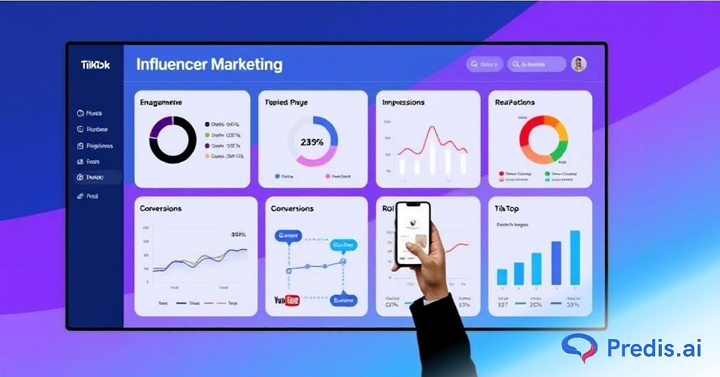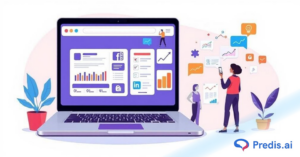Nowadays, businesses and marketers are drifting toward Influencer marketing to connect with their audience in a more genuine way. Brands can boost their visibility, build trust, and drive sales by collaborating with influencers who share a real connection with their followers and brands. For example, a beauty brand can partner with a makeup artist or a fitness company can team up with a wellness coach’s Instagram marketing. If you have the right influencer you can make a big impact. But, apart from choosing the right person for your influencer marketing campaign, you also need to track the right metrics to see what’s working and what isn’t. For a successful campaign. Without measuring the key performance indicators (KPIs), it’s not possible to fully know the impact of your campaign. In this blog, you’ll discover the top 10 metrics and KPIs for influencer marketing, every marketer like you, should track. From engagement and conversions to ROI, you’ll learn how to make your campaigns more effective and data-driven.
Why Should You Track KPIs & Metrics in Influencer Marketing?
To ensure that your campaigns are performing the way you want them to, it is very much important to track metrics in influencer marketing. Your campaign’s success is guaranteed, if you have clear data to back it up. Collaborating with influencers will increase your brand awareness and engagement only. Tracking KPIs and key metrics is very important as they provide insights into how well your campaign is performing, helping you understand what’s working and what needs improvement. You can also check out the top influencer marketing trends of 2025!
- By tracking the right metrics, you can align influencer efforts with your business goals, whether it’s increasing website traffic, boosting sales, or growing your social media following.
- To check if your money is put in the right direction, you can also measure the return on your investment (ROI).
- In short, Influencer marketing metrics help in making informed decisions, optimized strategies, and building stronger and effective influencer collaborations.
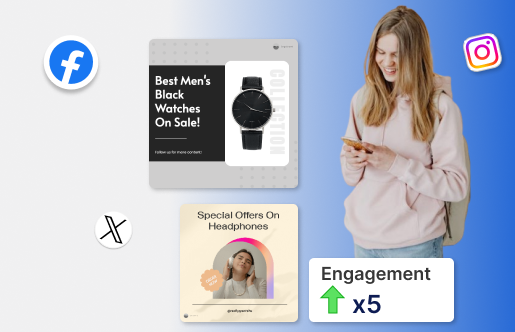
Important Metrics and KPIs to Track in Influencer Marketing
You need to focus on metrics and KPIs that are in alignment with your goal, to measure the success of your influencer marketing campaigns. Below is a breakdown of the most important ones to track:
1. Reach and Impressions
These metrics indicate how many people saw the influencer’s content (reach) and the total number of times it appeared on screens (impressions), even if the same person saw it multiple times. By tracking these metrics you will be able to assess how visible your campaign is and also the potential audience size.
- If the reach is high, it means the influencer is helping your brand connect with a large audience.
- If impressions are higher than reach, it indicates that people are seeing the content multiple times, which can help with brand recall.
- Brand recall is also an important metric that shows how easily consumers can remember a brand, either when prompted or without prompting.
- Tracking reach and impressions can also help you to identify which platforms or influencers give you the most visibility. This information is important for planning your future campaigns to make sure your campaign reaches as many people as possible.
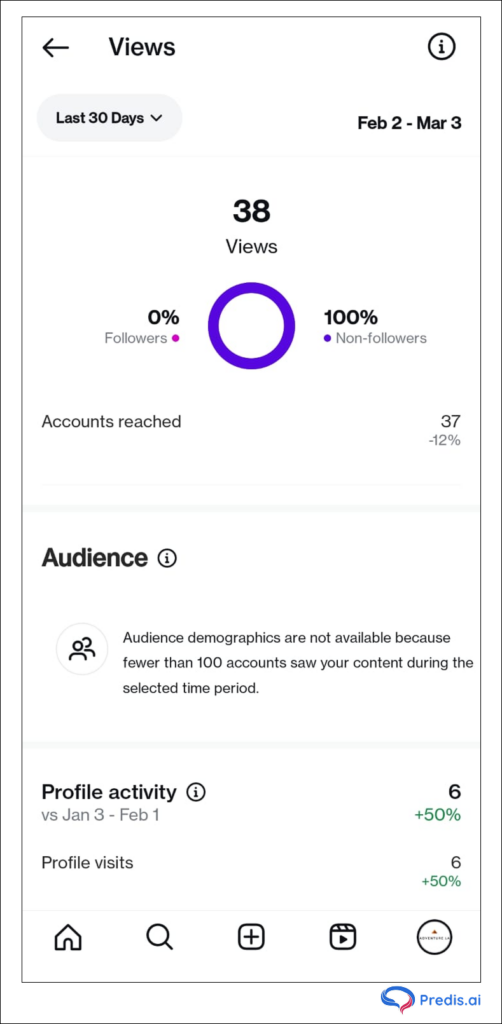
2. Engagement Rate
This measures how active the audience are in interacting with the influencer’s content. Engagement metrics include likes, comments, shares, and clicks.
- If you have a higher engagement rate, that means users or your targeted audience is engaging with your content more and your content is exactly what they are looking for. This will push them to take the required action.
- Engagement reflects the real interest of the users and hence is more important than the number of followers.
- For example, an influencer with a smaller, engaged audience can deliver better results than one with a large but unresponsive following.
- Tracking engagement helps you understand what type of content works best. Is the audience engaging more with videos, photos, or stories? You can use this insight to refine your messaging and create content that connects with your target audience.
3. Click-Through Rate (CTR)
CTR shows the percentage of people who clicked on a link shared by the influencer. It’s a clear indicator of how effective the content is at driving traffic to your website or landing page.
- For example, if an influencer includes a link to your product in their Instagram bio or swipe-up story, CTR will tell you how many people found the content compelling enough to click through.
- A higher CTR means the influencer is delivering the right message to the right audience.
- If the CTR is low, it may signal that the content, call-to-action, or audience alignment needs improvement.
4. Conversion Rate
Conversion rate is the percentage of people who took a specific action after clicking on the content. You can find out the conversion rate by using this formula:
Conversion Rate (%) = (Number of Conversions/Total Number of Visitors or Clicks )×100
- A conversion can be in the form of making a purchase, signing up for a newsletter, or downloading an app.
- This metric directly shows the success of your campaign goals and also shows how successful the influencer is at driving desired results.
- For example, If your goal is to sell a particular product, then by tracking the conversion rate you will be able to measure the campaign’s success.
- A high conversion rate proves that your campaign is working.
- Understanding the conversion rates also helps you to calculate ROI and adjust your strategies to improve and increase your outcomes in future campaigns.
5. Cost Per Engagement (CPE)
CPE calculates the cost of each interaction generated by the campaign, such as likes, comments, shares, or clicks. It’s a useful way to measure how cost-effective your influencer partnership is.
- For example, if you paid $500 for a campaign that generated 1,000 engagements, your CPE would be $0.50 per engagement.
- A lower CPE means you’re getting more value for your investment.
- Comparing CPE across different influencers can also help you to identify which partnerships are worth continuing or scaling.
6. Return on Investment (ROI)
ROI is the ultimate measure of your campaign’s success. It calculates the profit that is generated from the campaign compared to its cost.
- For example, if you spent $1,000 on a campaign and generated $3,000 in sales, your ROI would be 200%.
- This metric shows if the campaign delivered the required financial results and if it is worth the investment or not.
- Tracking ROI helps you to justify your marketing budget and plan future campaigns more effectively.
7. Audience Demographics
Audience demographics include details like age, gender, location, and interests of the influencer’s followers.
- This information helps you to make sure that the influencer’s audience is aligning with your target market as well.
- For example, if you’re a skincare brand and want to target women aged 25–40, then partnering with an influencer whose audience matches this profile will give you the best chance of success.
- You need to review audience demographics to avoid wasting resources on influencers whose audience is no longer relevant to your product or service.

8. Brand Mentions and Sentiment Analysis
Brand mentions is an important metric that tracks how often and where people are talking about your brand during a campaign.
- Sentiment analysis is one step further. It shows the reaction of your audience towards your brand. The reaction can be positive, negative or neutral based on how the audience is perceiving your brand.
- For example, if you find your product being mentioned with positive feedback, then your campaign is building trust and goodwill.
- Whereas, if people have negative sentiments that shows the areas that need to be improved such as improvements in product or messaging.
- You can measure how visible your brand is and understand how your campaign is influencing public perception, by monitoring these metrics.
9. Follower Growth
Follower growth measures how many new social media followers your brand has gained during and after a campaign. This metric shows the long-term impact of influencer collaborations.
- If you notice a steady increase in followers, it’s a sign that the influencer is effectively attracting people to your brand.
- These new followers can become loyal customers with the right engagement and content strategy.
- Tracking follower growth also helps you assess which influencers are the best fit for growing your online presence.
10. Content Performance Metrics
Content performance metrics is very important for tracking the performance of specific posts or stories. You need to check data such as video views, story taps, saves, and share, to track content performance metrics,
- For example, if a video is getting a lot of views and has become popular because of a very high number of shares across the platform, then the content definitely resonates with the audience.
- More saves and shares are very important because they indicate long-term interest and also means that the content is being revisited or shared with others.
- These insights help you identify what type of content works best and refine your strategy to produce more of what your audience loves.
How to Use These Metrics to Optimize Future Campaigns?
Using the right influencer marketing metrics helps to understand the performance of your current campaigns and also helps to improve the future ones. To optimise and plan your future campaigns, you need to start by analyzing which metrics align best with your goals. For example, if you’re looking to increase brand awareness, focus on reach and engagement. If driving sales is your priority, pay closer attention to conversion rates and ROI.
Effective KPIs start with accepted collabs. If your outreach isn’t earning replies, you’ll have little reach, CTR, or conversions to measure. Use an influencer collaboration email template featuring proven outreach examples (gifting, paid partnerships, giveaways, product reviews) to increase reply and acceptance rates, accelerate launch timelines, and set up campaigns you can accurately track. Stronger acceptance upfront typically lifts engagement rate, reduces CPE, and improves ROI across subsequent reports.
Use the data to identify patterns. Which type of content performed well? Which influencers delivered the best results? These insights are very useful to decide the right type of influencers, right creation of content and helps in setting campaign goals in the future. By continuously evaluating and adjusting your strategy, you can ensure each campaign is better than the last.
Tools to Track Influencer Marketing Metrics
You can easily track the KPIs and performance metrics by using a variety of tools. Choosing the right tool depends on your campaign goals, budget, and the platforms you’re using.
- Platforms like Google Analytics can help you track website traffic and conversions from influencer campaigns.
- Sprout Social and Hootsuite are excellent for monitoring engagement, reach, and audience demographics on social media.
- You can use Predis AI, for doing the competitor analysis, so that you are aware of what your competition is doing and what is missing from your influencer marketing campaigns.
- For influencer-specific insights, tools like HypeAuditor, Upfluence, and Traackr offer detailed analytics on influencer performance, audience authenticity, and campaign ROI.
- BrandLovrs is a platform that provides tools for monitoring and analyzing metrics for influencer campaigns
- Grin prioritizes long-term relationship management between brands and influencers
- Influencer Hero is an all-in-one tool for managing influencer campaigns, from finding influencers to tracking performance and managing affiliates. It uses AI and automation to help brands boost conversions.
Common Mistakes to Avoid When Tracking Metrics
- While tracking metrics is essential, it’s easy to make mistakes that can lead to misleading results.
- Avoid focusing solely on vanity metrics such as likes or follower counts—they don’t always reflect campaign success. Instead, prioritize actionable KPIs like engagement, conversions, and ROI.
- Another common mistake is ignoring the quality of interactions. If the comments and shares are not relevant and spammy, then having high engagement is meaningless. You need to have quality comments, shares, likes etc.
- Lastly, don’t overlook the importance of setting clear goals before starting your campaign. Without a roadmap, even the best metrics won’t give you the insights you need.
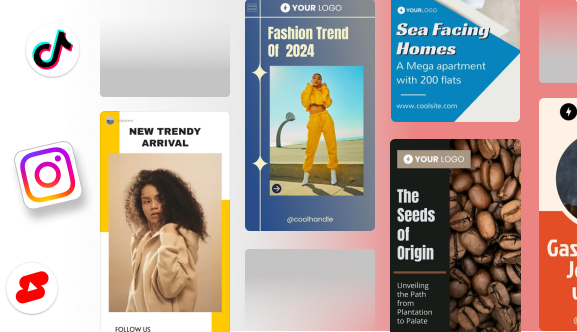
Conclusion
To run a successful campaign, you must consistently track influencer marketing metrics. You can create data-driven strategies to achieve your goals by monitoring the right KPIs, using reliable tools to track and analyze and avoiding common mistakes. These insights will also help you plan your future campaigns. Remember, every campaign is a learning opportunity. With the results and data that you get from tracking metric, you can build stronger collaborations with the right kind of influencers, optimize your efforts, and drive better results for your brand.


